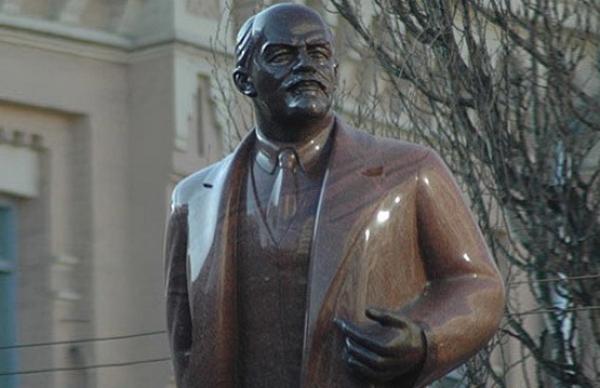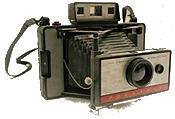Monuments |
Golden Gate (Zoloti Vorota)
Golden Gate (Zoloti Vorota) - The name comes from it′s similarity with Constantinopol′s Golden Gate. You can find this historical fortress on the corner of Volodymyrs′ka and Prorizna Street, next to the Metro Station Zoloti Vorota.
This unique monument was constructed by Yaroslav the Wise, Prince of Kiev, between 1017and 1024. It reflects the art of fortification of Kievan Rus.
Golden Gate was the main entrance into the grand city of Kyiv.
This unique structure served as a defensive tower and a church. Kievans called Golden Gate "the sky gate" as every morning the sun passed through it, rose and entered "the vault of heaven". It was an awesome view! The fortified construction of Zoloti Vorota was totally inaccessible. Nomadic tribes could never take it by assault, and even Batu Khan didn′t manage to enter the city through the Gate. Batu Khan′s Golden Horde stormed a less fortified Lyads′ki Gates and destroyed Zoloti Vorota from inside in 1240.
Golden Gate (Zoloti Vorota) - The name comes from it′s similarity with Constantinopol′s Golden Gate. You can find this historical fortress on the corner of Volodymyrs′ka and Prorizna Street, next to the Metro Station Zoloti Vorota.
This unique monument was constructed by Yaroslav the Wise, Prince of Kiev, between 1017and 1024. It reflects the art of fortification of Kievan Rus.
Golden Gate was the main entrance into the grand city of Kyiv.
This unique structure served as a defensive tower and a church. Kievans called Golden Gate "the sky gate" as every morning the sun passed through it, rose and entered "the vault of heaven". It was an awesome view! The fortified construction of Zoloti Vorota was totally inaccessible. Nomadic tribes could never take it by assault, and even Batu Khan didn′t manage to enter the city through the Gate. Batu Khan′s Golden Horde stormed a less fortified Lyads′ki Gates and destroyed Zoloti Vorota from inside in 1240.
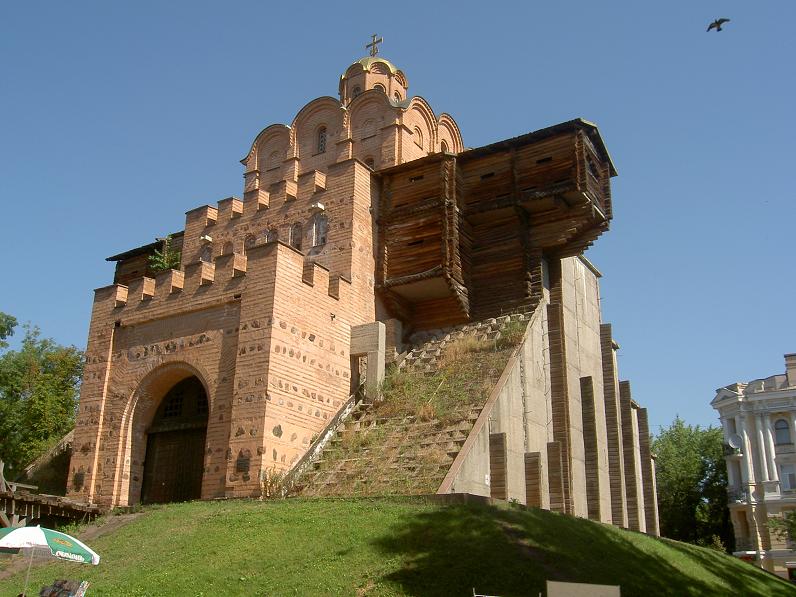
Monument to Yaroslav Mudry (Yaroslav The Wise)
Yaroslav Rurikide I, Grand Prince of Kiev "Yaroslav The Wise" or Yaroslav Mudry was born 980. He died 2 Feb 1054 in Kiev, Ukraine. Yaroslav married Ingegerd Ynglinga Olafsdatter, Princess of Sweden.
He was the "grand prince" of Kyiv from 1019 to 1054. A son of the grand prince Vladimir, he was vice-regent of Novgorod at the time of his father′s death in 1015. Yaroslav became the grand prince of Kiev in 1019.
He began consolidating the Kievan state through both cultural and administrative improvements and through military campaigns. He promoted the spread of Christianity in the Kievan state, gathered a large collection of books, and employed many scribes to translate Greek religious texts into the Slavic language.
He founded churches and monasteries and issued statutes regulating the legal position of the Christian Church and the rights of the clergy. With the help of Byzantine architects and craftsmen, Yaroslav fortified and beautified Kiev along Byzantine lines. He built the majestic Cathedral of St. Sophia and the famous Golden Gate (Zoloti Vorota) of the Kievan fortress.* The legend says that before the final battle with powerful Pechenegs, Yaroslav Mudry prayed and begged the Virgin to help him to defeat the enemy. He promised to build the church dedicated to the Mother of God in case of success. He did not forget his promise and ordered the Golden Gate topped with the gilded-domed Annunciation Church.
The monument shows Yaroslav The Wise, holding a model of Saint Sofia Cathedral. It was unveiled in 1997
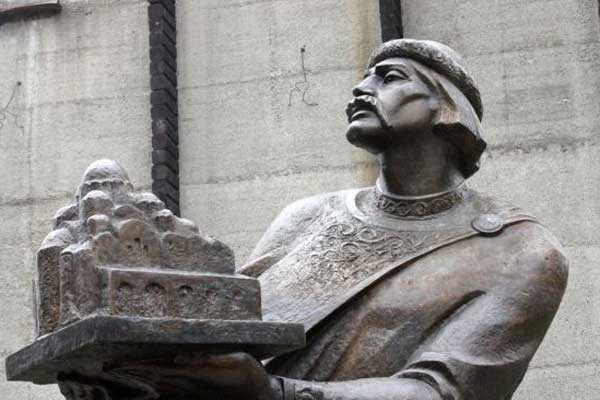
Monument to Bohdan Khmel′nyts′ky
Among Kyiv′s best-known public monuments is the statue of Bohdan Khmel′nyts′ky. (Bohdan Zynovii Mykhailovych Khmel′nyts′ky commonly transliterated as Khmelnytsky, and known in Polish as Bogdan Zenobi Chmielnicki)
He was a Polish-Lithuanian Commonwealth Noble of Polish or Ruthenian origin, and leader of the Zaporozhian Cossack Hetmanate, Hetman of Ukraine.
Bohdan Khmel′nyts′ky was noted for his revolt against Poland (1648 – 1654) and the Treaty of Pereyaslavl′ which eventually led to the annexation of Ukraine by the Russian Empire.
(The five Hryvnia Ukrainian banknotes depicte Bohdan Khmel′nyts′ky).
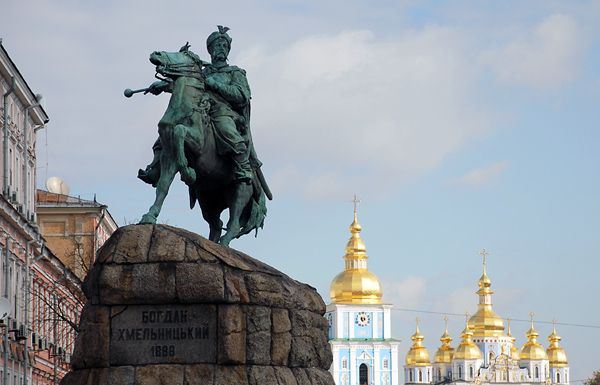
Prince Volodymyr Monument
On the slopes of the Volodymyr Hill and overlooking the Dnipro River there is a monument to Grand Prince Olha′s grandson, Volodymyr who is also called the Baptiser of Rus, as he introduced Christianity into Old Rus in 988.
Volodymyr, his family, and his closest associates were baptised in December 987, when he took the Christian name Vasylii (Basil). Soon afterward he ordered the destruction of all pagan idols.
The mass baptism of the citizens of Kyiv took place on August 1, 988. The remaining population of Rus’ were slowly convertedas well, though sometimes by force.
During Volodymyr′s reign the first schools and churches were built, notably the Church of the Tithes in Kyiv.
The adoption of Christianity as the official religion facilitated the unification of the Rus’ tribes and the establishment of foreign dynastic, political, cultural, religious, and commercial relations, particularly with the Byzantine Empire, Bulgaria, and Germany.
Relations with Poland improved after Volodymyr′s, son Sviatopolk I, married the daughter of Prince Boles?aw I the Brave in 992.
Volodymyr expanded the borders of Kyivan Rus’ and turned it into one of the most powerful states in Eastern Europe.
The Rus’ clergy venerated Volodymyr because of his support of the church, but he was canonized only after 1240. Thereafter he was referred to as ‘the holy, equal to the Apostles, grand prince of Kyiv.’A bronze statue of Grand Prince Volodymyr was erected in 1853 in Kyiv.

The Monument of Motherland
Kyiv′s statue of the Motherland is a memorial of the Great Patriotic War (World War II). The statue itself is 62 meters (203.4 feet) tall, the overall height is 102 meters (334.6 feet). (You can find links to conversion calculators on our Travel Forum)
The figure is made of a chrome nickel steel variation and weighs about 450 tons.
In the left hand the figure is holding a shield which is decorated with the state symbol of the USSR (13 tons). In the right hand there is a sword which weighs 9 tons and is 16 meters (52.5 feet) long. The monument was opened by L.Brezhnev in 1981.
"The National Museum of the history of World War II" is located at the base of the statue. Its base begins at a depth of 17,8 meters (58.4 feet) below the museum entrance. There’s a concrete well with a diameter of 34 meters (111.5 feet), reaching down 17.8 meters also.
The Statue’s "skeleton" is made from stainless steel and was produced in Zaporizhzhya. It was the first statue of it′s size ever made in the USSR. Its final construction was in the Kyiv factory Parizhskoi Kommuny with the help of the Institute of Electric Welding, ie; Patona.
The monument was assembled with the use of a 100 meters (328 feet) tall crane, specially made in Donbass. It is calculated, that the statue can survive a 9 point earthquake and should last for over 150 years.
There are two lifts (elevators) inside the statue. It was previously possible to go inside the head, sword and shield areas, but in 2002 the access for tourists was limited, due to a series of accidents.
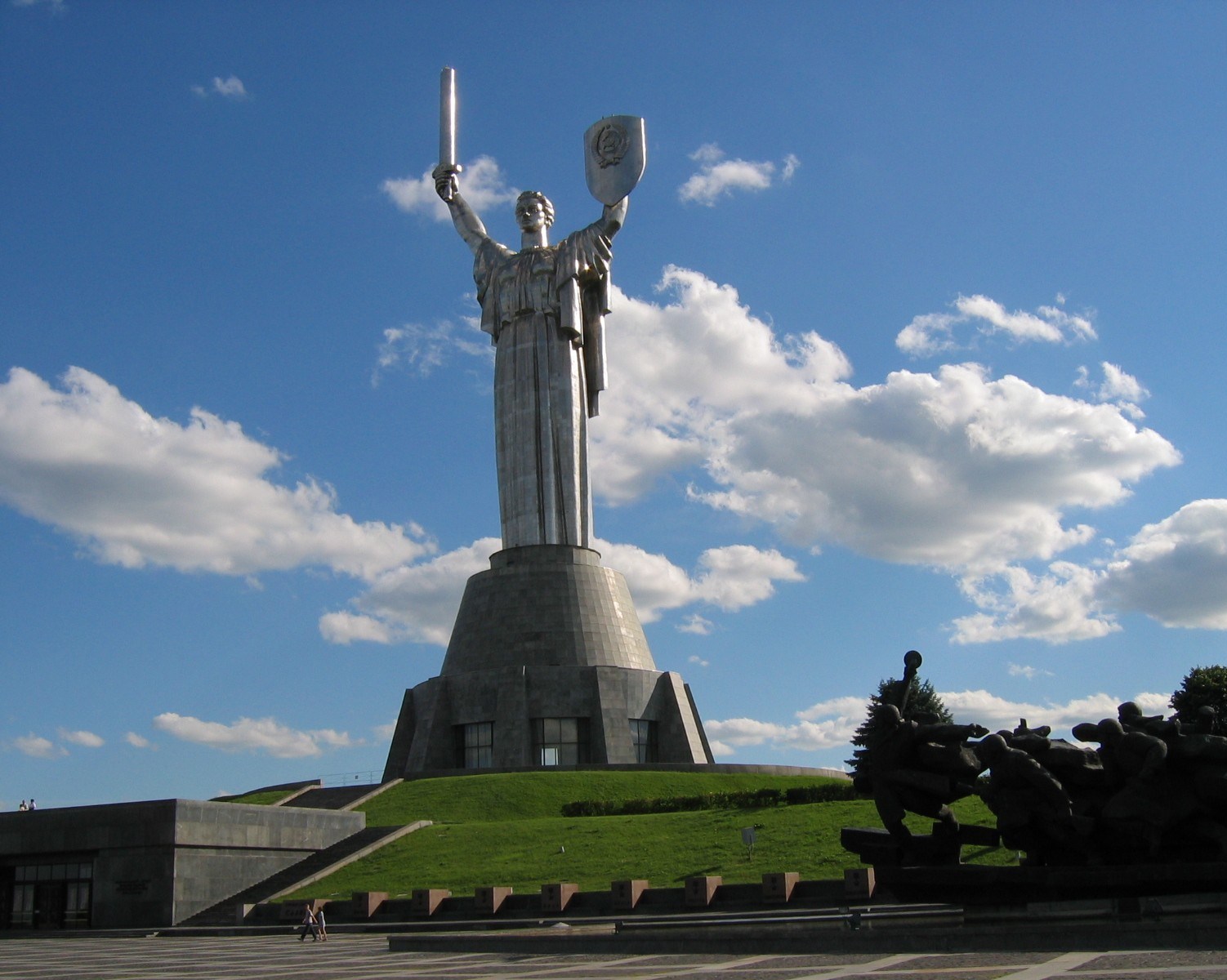
Monument to Founders of Kyiv
This prominent riverside monument to the founders of Kyiv – Kyi, Shchek, Khoriv and their sister Lybid was unveiled in 1982 at the foot of Pechersky plateau on the bank of the Dnipro.
It was created by Vasily Borodai along with architect N. Feschenko.
The sculpture is a boat with the three brothers standing at the stern with two holding spears and Kyi holding a large bow.
Lybid stands tall and strong at the bow, with the wind gracefully lifting her cloak. (Unveiled in 1982).
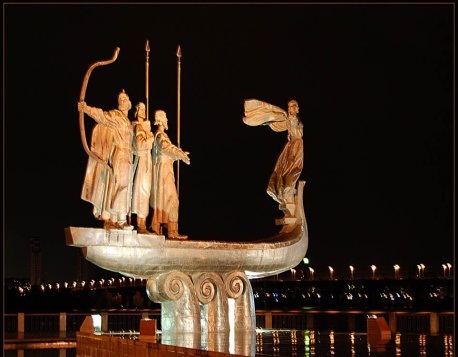
Pronya Prokopivna and Svirid Golokhvastov
Uphill from Andriyvs′ka Church on Desyatynna Street (just the beginning of Andriyvsky Uzviz) you′ll find the monument dedicated to Pronya Prokopivna Sirkova and Svirid Petrovich Golokhvastov, characters of the cinema version of Mikhail Staritskiy Play "After Two Hares". Many tourists take pictures with Pronya and Svirid, even if it means standing in line. Pronyas waist has taken on a polished brightness from the many hands that have embraced her for pictures. Unveiled in 1999.
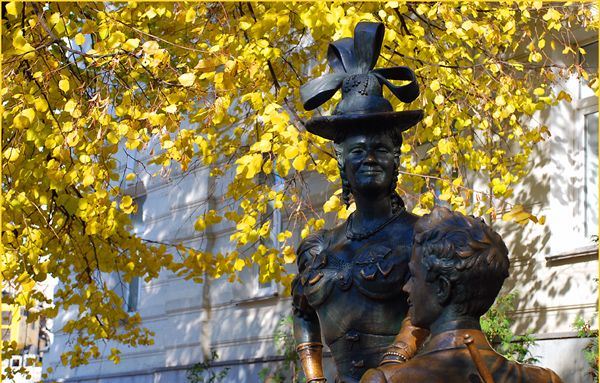
Arch of Peoples′ Friendship
Arch of Peoples′ Friendship is a wonderful sculptural, located in the heart of Kiev. It opened in 1982, and was timed to celebrate the 1500 anniversary of the capital. This monument is located in Hreschatom park, formerly known as Merchant′s garden, which was a favorite place for hiking among the local intelligentsia. In the middle of the park was located unique figural flower bed, adorned with a statue of Apollo - the god of the ancient arts, in his hands he held a traditional lyre. Nearby stood a summer stage. There were all sorts of concerts and performances. Subsequently, the Arch of Friendship of Peoples replaced this summer stage. Its authors were AP Skoblikov (sculpture), IN Ivanov, SN Mirgorodskii and KA Ford (architect).
Arch of Friendship of the People - is a monument dedicated to the reunification of Ukraine and Russia, consisting of three elements. Among them: the very arch, designed as a huge rainbow, working in bronze sculpture and a stage Pereiaslav happy, hewn from granite. In the center of this composition are two statues: Bohdan Khmelnytsky and the Russian ambassador - Boyar Buturlina. As a result Pereiaslav glad 1654 was entered into a historic agreement, indicating the merger of the two states of Ukraine and Russia. It was signed by Ukrainian Hetman Bohdan Khmelnytsky and the Russian ambassador boyar Vasily Buturlin. The composition of workers is a six-meter statue dvuhfigurnuyu Russian and Ukrainian. It is made of metal, granite and bronze. Both are working together keep the tape from the Order of Friendship of Peoples. Together all these groups of sculptures band performed in a rainbow arch of Friendship of Peoples, which identifies a union of fraternal peoples. If you stand behind the monument, you will find yourself on the lookout. It offers a magnificent view overlooking the Dnieper river and the Left Bank. Source http://gyrno.net
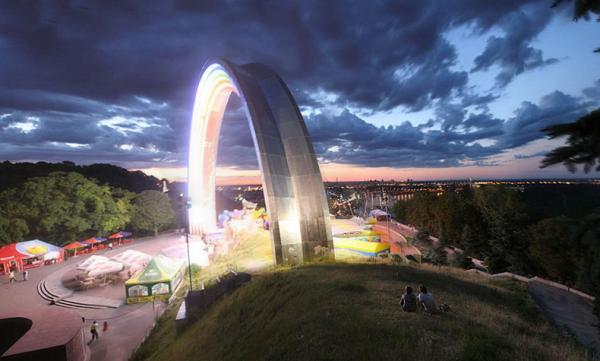
Monument to Lenin
December 5, 1946 in Kiev was a monument to the head of the Bolshevik Party and head of the 1917 October Revolution in Russia - Vladimir Ilyich Lenin. The monument is located on the axis of the boulevard, Khmelnitsky, at the intersection of it with Khreschatik - Kiev′s main street. Lenin statue is set so that the leader of the proletariat as it appeals to people. His figure is made of dark-red polished granite, which is very successfully combined with a pedestal made of black labradorite. The base of the monument - a square platform. To her are stairs sloping semicircular shape. In the center of the pedestal bears the inscription "Lenin", and on each side - his words: "In a single action of the proletarians of the Great Ukrainian and free Ukraine is possible without such unity it is out of question" and "will never win that people, in which the workers and peasants for the most part learned, felt and saw that they were defending their own, Soviet power - the power of working people that defend the matter, a victory which they and their children provide an opportunity to enjoy all the benefits of culture, all creatures of human labor "(VI Lenin).
At the height of the monument to Lenin reaches 3.45 meters. The authors of the monument are C. Mercury (sculptor), Vlasov and V. Elizarov (architects). Source http://gyrno.net
At the height of the monument to Lenin reaches 3.45 meters. The authors of the monument are C. Mercury (sculptor), Vlasov and V. Elizarov (architects). Source http://gyrno.net
